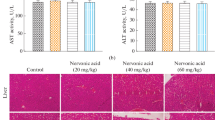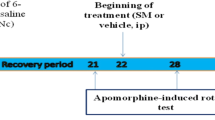Abstract
Parkinson’s disease (PD) is a progressive neurodegenerative disorder whose etiology is not understood. The 1-methyl-4-phenyl-1,2,3,6-tetrahydropyridine (MPTP)-treated mouse model is widely used for studying PD. The present study was undertaken to investigate the effect of hydroxysafflor yellow A (HSYA) on MPTP-induced neurotoxicity in mice. Pretreatment with HSYA at a dose of 2, 8 mg/kg for a week was followed by intraperitoneal injection with MPTP (30 mg/kg) for five consecutive days. Next, the subsequent behavior, biochemical index and immunohistochemical manifestations in mice were determined. Behavioral testing showed that MPTP-treated mice exhibited motor deficits but HSYA at dose of 8 mg/kg prevented the appearance of motor abnormalities. Treatment with HSYA at dose of 8 mg/kg attenuated the reduction of dopamine (DA), 3,4-dihydroxyphenylacetic acid (DOPAC) and homovanillic acid (HVA) in striatum. It also showed that the activity of SOD, catalase activity and GSH levels were significantly higher, while the levels of malondialdehyde (MDA) and hydroxyl radicals was lower, in the HSYA-treated mice compared to the MPTP-treated mice. The MPTP-treated mice exhibited the loss of tyrosine hydroxylase-containing dopaminergic neurons in substantia nigra. However, HSYA-treated mice showed a protective effect. Our results indicated that HSYA possesses neuroprotective effects and is a promising anti-Parkinson’s disease drug which is worthy of further study.





Similar content being viewed by others
References
Hornykiewicz O, Kish SJ (1987) Biochemical pathophysiology of Parkinson’s disease. Adv Neurol 45:19–34
Sayre LM, Perry G, Smith MA (2008) Oxidative stress and neurotoxicity. Chem Res Toxicol 21:172–188
Langston JW, Ballard P, Tetrud JW et al (1983) Chronic Parkinsonism in humans due to a product of meperidine-analog synthesis. Science 219:979–980
Tipton KF, Singer TP (1993) Advances in our understanding of the mechanisms of the neurotoxicity of MPTP and related compounds. J Neurochem 61:1191–1206
Schmidt N, Ferger B (2001) Neurochemical findings in the MPTP model of Parkinson’s disease. J Neural Transm 108:1263–1282
Romano C, Price M, Bai HY et al (1993) Neuroprotectants in Honghua: glucose attenuates retinal ischemic damage. Invest Ophthalmol Vis Sci 34:72–80
Wei X, Liu H, Sun X et al (2005) Hydroxysafflor yellow A protects rat brains against ischemia-reperfusion injury by antioxidant action. Neurosci Lett 386:58–62
Tian J, Li G, Liu Z (2008) Hydroxysafflor yellow A inhibits rat brain mitochondrial permeability transition pores by a free radical scavenging action. Pharmacology 82:121–126
Sundström E, Fredriksson A, Archer T (1990) Chronic neurochemical and behavioral changes in MPTP-lesioned C57BL/6 mice: a model for Parkinson’s disease. Brain Res 528:181–188
Sedelis M, Hofele K, Auburger GW et al (2000) MPTP susceptibility in the mouse: behavioral, neurochemical, and histological analysis of gender and strain differences. Behav Genet 30:171–182
Araki T, Mikami T, Tanji H et al (2001) Biochemical and immunohistological changes in the brain of 1-methyl-4-phenyl-1,2,3,6-tetrahydropyridine (MPTP)-treated mouse. Eur J Pharm Sci 12:231–238
McCord JM, Fridovich I (1969) Superoxide dismutase. An enzymic function for erythrocuprein (hemocuprein). J Biol Chem 244:6049–6055
Aebi H (1984) Catalase in vitro. Methods Enzymol 105:121–126
Cohn VH, Lyle J (1966) A fluorimetric assay for glutathione. Anal Biochem 14:434–440
Ohkawa H, Ohishi N, Yagi K (1979) Assay for lipid peroxides in animal tissues by thiobarbituric acid reaction. Anal Biochem 95:351–358
Thomas B, Muralikrishnan D, Mohanakumar KP (2000) In vivo hydroxyl radical generation in the striatum following systemic administration of 1-methyl-4-phenyl-1,2,3,6-tetrahydropyridine in mice. Brain Res 852:221–224
Lowry OH, Rosebrough NJ, Farr AL et al (1951) Protein measurement with the Folin phenol reagent. J Biol Chem 193:265–275
Dhanasekaran M, Albano CB, Pellet L et al (2008) Role of lipoamide dehydrogenase and metallothionein on 1-methyl-4-phenyl-1,2,3,6-tetrahydropyridine-induced neurotoxicity. Neurochem Res 33:980–984
Willis GL, Donnan GA (1987) Histochemical, biochemical and behavioural consequences of MPTP treatment in C-57 black mice. Brain Res 402:269–274
Przedborski S, Jackson-Lewis V (1998) Mechanisms of MPTP toxicity. Mov Disord 13(Suppl 1):35–38
Muralikrishnan D, Ebadi M, Brown-Borg HM (2002) Effect of MPTP on dopamine metabolism in Ames dwarf mice. Neurochem Res 27:457–464
Muralikrishnan D, Mohanakumar KP (1998) Neuroprotection by bromocriptine against 1-methyl-4-phenyl-1,2,3,6-tetrahydropyridine-induced neurotoxicity in mice. FASEB J 12:905–912
Haavik J, Toska K (1998) Tyrosine hydroxylase and Parkinson’s disease. Mol Neurobiol 16:285–309
Hurley FM, Costello DJ, Sullivan AM (2004) Neuroprotective effects of delayed administration of growth/differentiation factor-5 in the partial lesion model of Parkinson’s disease. Exp Neurol 185:281–289
Oiwa Y, Yoshimura R, Nakai K et al (2002) Dopaminergic neuroprotection and regeneration by neurturin assessed by using behavioral, biochemical and histochemical measurements in a model of progressive Parkinson’s disease. Brain Res 947:271–283
Acknowledgment
The authors thank Prof. Lon Clark for the English language revision.
Author information
Authors and Affiliations
Corresponding author
Rights and permissions
About this article
Cite this article
Han, B., Zhao, H. Effects of Hydroxysafflor Yellow A in the Attenuation of MPTP Neurotoxicity in Mice. Neurochem Res 35, 107–113 (2010). https://doi.org/10.1007/s11064-009-0035-4
Received:
Accepted:
Published:
Issue Date:
DOI: https://doi.org/10.1007/s11064-009-0035-4




